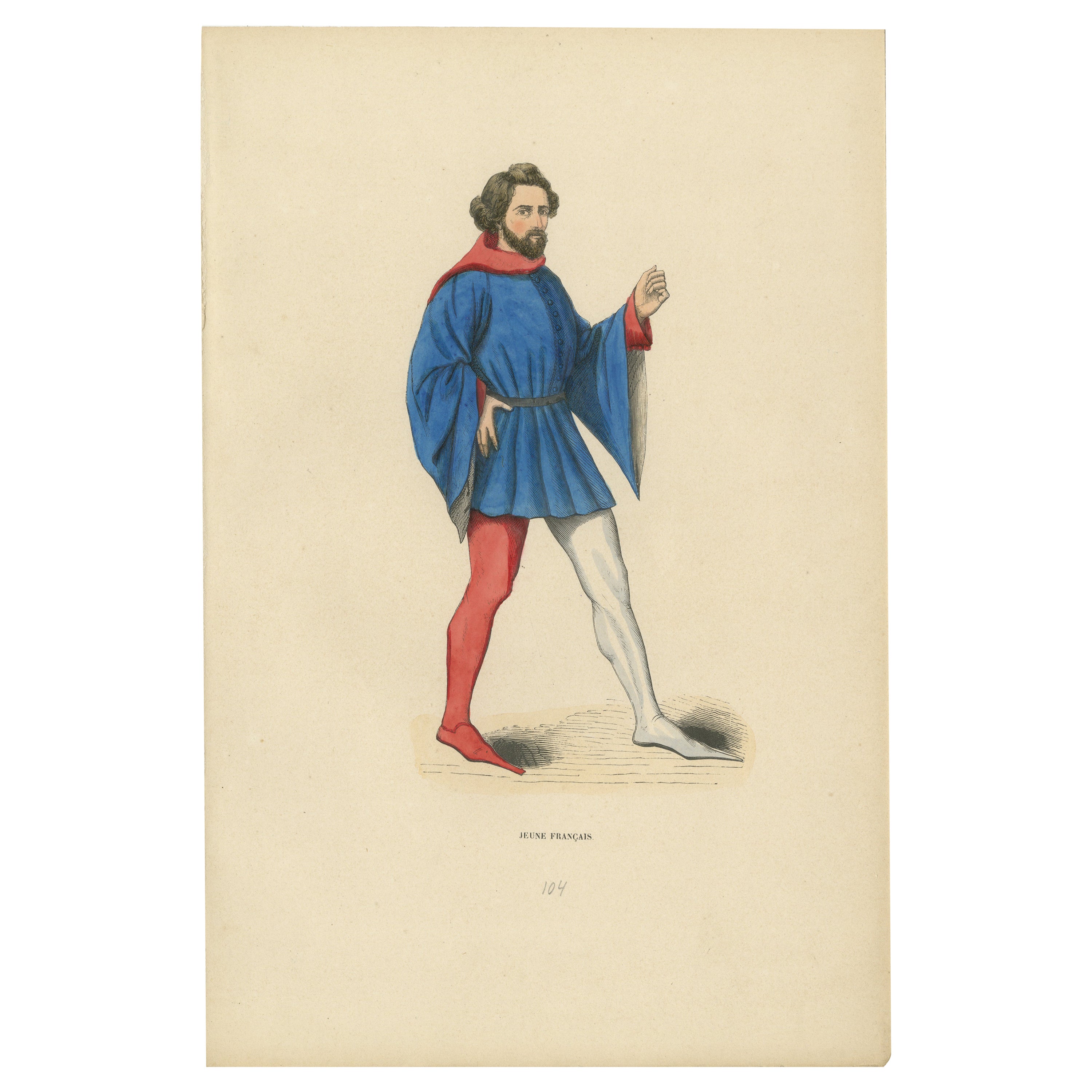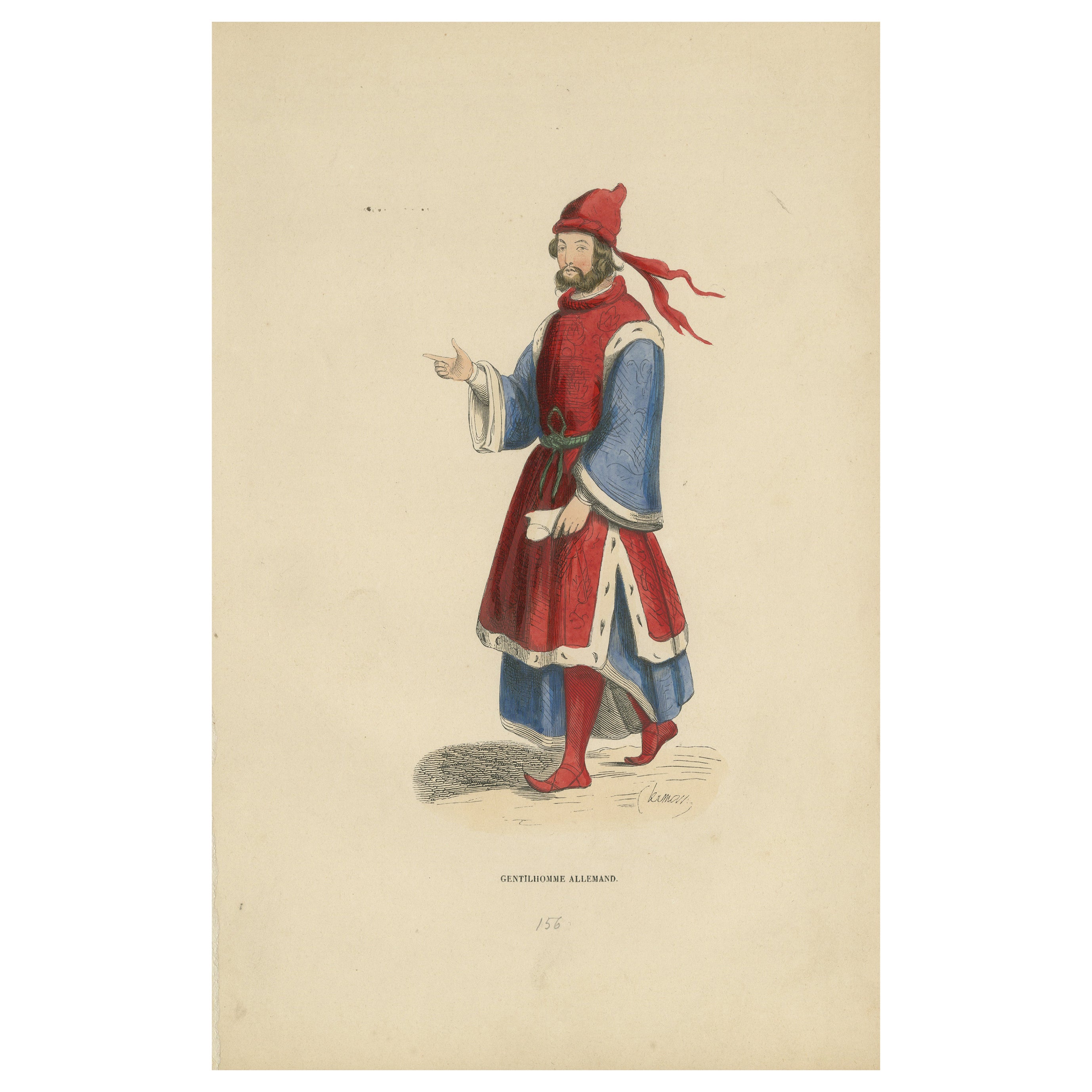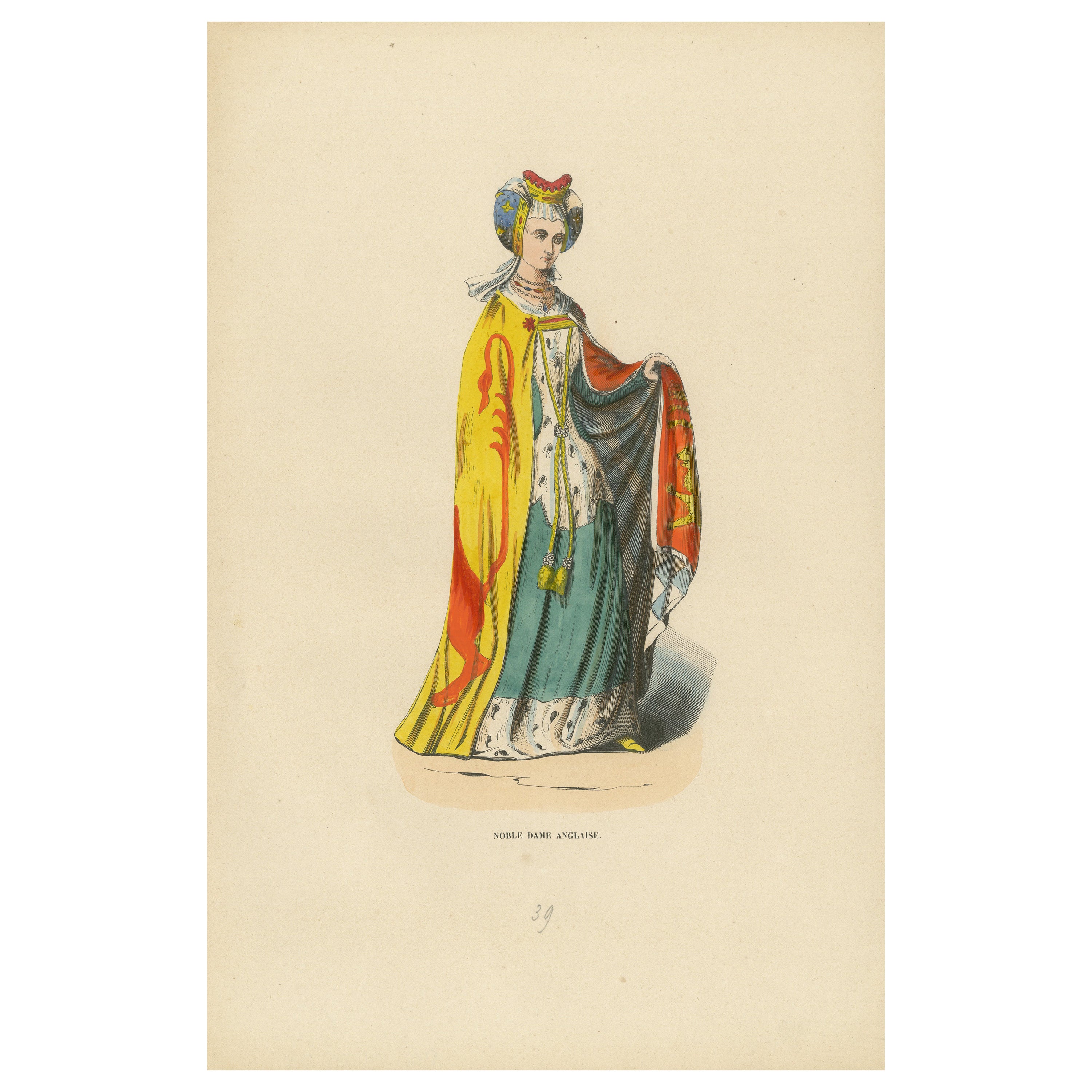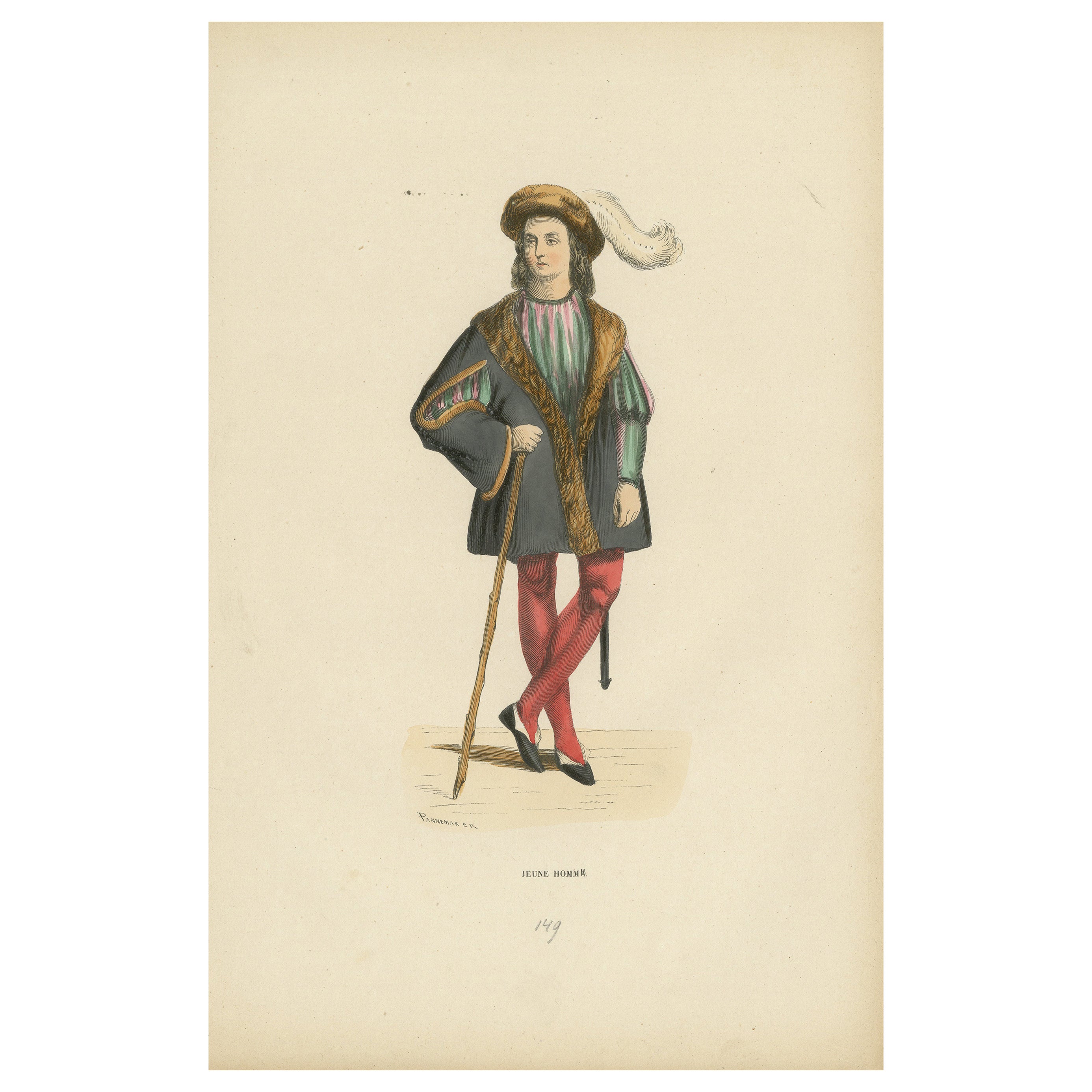Items Similar to 13th Century Elegance: A Noblewoman Amidst Nature in Medieval Attire, 1847
Want more images or videos?
Request additional images or videos from the seller
1 of 6
13th Century Elegance: A Noblewoman Amidst Nature in Medieval Attire, 1847
About the Item
"Dame du XIIIe Siècle" (Lady of the 13th Century)
Description: This delicate hand-colored engraving from the 1847 "Costume du Moyen Age" series depicts a lady from the 13th century. The title, "Dame du XIIIe Siècle," suggests an emphasis on historical accuracy in representing the fashion of that era.
The lady is garbed in a long, flowing blue gown with tight-fitting sleeves, a style characteristic of the period. The gown is cinched at the waist with a decorative belt adorned with what appears to be metallic accents, highlighting the narrow waistline favored in feminine fashion of the time. Her dress drapes gracefully to the ground, hiding her feet, which adds to the modesty and elegance of her stance.
She holds a bouquet of flowers, perhaps wildflowers, indicative of an appreciation for nature, a common motif in medieval art. Her attention is tenderly focused on a single flower, suggesting a moment of contemplation or enjoyment of its beauty.
Her hair is styled long and loose, cascading down her back, which was often a sign of youth and beauty in medieval times. The simple yet noble elegance of her attire, coupled with her serene expression, portrays the lady as both graceful and dignified.
The background is minimally detailed with a hint of a natural landscape, ensuring the viewer's focus remains on the lady and her refined attire. The artistry of the engraving captures the romanticism often associated with medieval times, as well as the intricate details of the clothing worn during the 13th century.
The colors have a nice glow over them. Historically, egg whites, known as glair, and sometimes egg yolk were indeed used in illumination and painting, particularly in manuscripts, to give colors a brighter appearance and to add a sheen or gloss to the work. This technique was quite common during the Middle Ages and into the Renaissance.
Egg whites can be applied as a varnish over pigments to enhance their brightness and to protect the colors. This application could make the colors appear more vivid and also add a slight glossy sheen to the surface of the image.
Egg yolk, on the other hand, was commonly used as a binding agent in paint. It forms the basis of tempera paint, a medium that was widely used before the advent of oil painting. Egg yolk helps to create a durable and long-lasting color that adheres well to various surfaces.
In the context of the print from 1847, it's less likely that egg whites or yolks were used directly on the print, as by that time, commercial printing processes would have been more advanced and less reliant on such manual methods. However, if this print is a representation of an earlier style or is meant to mimic the appearance of hand-painted manuscripts, the original artists might have employed techniques or materials that gave a similar effect to those achieved with egg-based binders and varnishes.
- Dimensions:Height: 10.63 in (27 cm)Width: 7.09 in (18 cm)Depth: 0 in (0.02 mm)
- Materials and Techniques:
- Period:
- Date of Manufacture:1847
- Condition:Good. Overal light toning and light soiling but the image itself clean and hand-colored almost 200 years ago and still in expliciet colors. Aged paper with typically warm, yellowish-brown hue, mostly around the edges. Study the images carefully.
- Seller Location:Langweer, NL
- Reference Number:
About the Seller
5.0
Platinum Seller
These expertly vetted sellers are 1stDibs' most experienced sellers and are rated highest by our customers.
Established in 2009
1stDibs seller since 2017
1,922 sales on 1stDibs
Typical response time: <1 hour
- ShippingRetrieving quote...Ships From: Langweer, Netherlands
- Return PolicyA return for this item may be initiated within 14 days of delivery.
More From This SellerView All
- French Youth in Traditional Medieval Attire, 1847Located in Langweer, NLTitle: "French Youth in Traditional Medieval Attire" Description: This hand-colored engraving, titled "Jeune Français," which translates to "Young Frenchman," is part of the histori...Category
Antique 1840s Prints
MaterialsPaper
- Noble Bearing: A German Gentleman in Medieval Attire, 1847Located in Langweer, NLTitle: "Noble Bearing: A German Gentleman in Medieval Attire from 'Costume du Moyen Âge'" Description: This 1847 lithograph from the esteemed collection "Costume du Moyen Âge" showc...Category
Antique 1840s Prints
MaterialsPaper
- English Noblewoman in Traditional Attire, Costume Di Moyen Age, 1847Located in Langweer, NLThis print presents an English noblewoman from the Middle Ages, dressed in a luxurious gown that reflects her high status. She wears an elaborate headdress, which was fashionable among the upper classes during that era. Her dress is adorned with intricate patterns and heraldic motifs, suggesting her family's noble lineage. The cape, vibrant in color and decorated with a complex design, drapes elegantly over her shoulders, indicative of the elaborate styles of the medieval nobility. More about the vivid colors of this original hand-colored antique print: The colors have a nice glow over them. Historically, egg whites, known as glair, and sometimes egg yolk were indeed used in illumination and painting, particularly in manuscripts, to give colors a brighter appearance and to add a sheen or gloss to the work. This technique was quite common during the Middle Ages and into the Renaissance. Egg whites can be applied as a varnish over pigments to enhance their brightness and to protect the colors. This application could make the colors appear more vivid and also add a slight glossy sheen to the surface of the image. Egg yolk, on the other hand, was commonly used as a binding agent in paint. It forms the basis of tempera paint, a medium that was widely used before the advent of oil painting. Egg yolk helps to create a durable and long-lasting color that adheres well to various surfaces. In the context of the print from 1847, it's less likely that egg whites or yolks were used directly on the print, as by that time, commercial printing processes would have been more advanced and less reliant on such manual methods. However, if this print is a representation of an earlier style or is meant to mimic the appearance of hand-painted...Category
Antique 1840s Prints
MaterialsPaper
- Louis IX: A Portrayal of French Royalty in Medieval Attire, Published in 1847Located in Langweer, NLThe image is a hand-colored engraving titled "Louis IX," representing the 13th-century King of France, also known as Saint Louis, renowned for his Christian zeal and justice. It is p...Category
Antique 1840s Prints
MaterialsPaper
- Youthful Elegance: A Young Gentleman's Attire in 'Costume du Moyen Âge', 1847Located in Langweer, NLTitle: "Youthful Elegance: A Young Gentleman's Attire in 'Costume du Moyen Âge'" Description: This lithograph, part of the 1847 "Costume du Moyen Âge" series, depicts a young gentle...Category
Antique 1840s Prints
MaterialsPaper
- Ecclesiastical Elegance: Artifacts of Faith from the 13th and 15th CenturiesLocated in Langweer, NLThese two antique handcolored lithographs are colored prints from the book "Costume du Moyen Âge" published in 1847. The prints depict detailed ecclesiastical items from the Middle A...Category
Antique 1840s Prints
MaterialsPaper
You May Also Like
- Original Antique Print of a 13th Century Illumination, circa 1900Located in St Annes, LancashireWonderful print of a 13th century illuminated miniature initial from a psalter Chromolithograph Published circa 1900 Unframed. The measureme...Category
Antique Early 1900s English Gothic Prints
MaterialsPaper
- Original Antique Print of a 13th Century Illumination, circa 1900Located in St Annes, LancashireWonderful print of a 13th century illumination. Chromolithograph Published circa 1900 Unframed. The measurement is the paper sizeCategory
Antique Early 1900s English Gothic Prints
MaterialsPaper
- Original Antique Print of a 13th Century Limoges Enamel Casket, France, C.1860Located in St Annes, LancashireWonderful print of a 13th century Limoges enamel casket Lithograph Published by A.Morel, Paris, France. circa 1860 Unframed. ...Category
Antique 1860s English Gothic Prints
MaterialsPaper
- A French Nature Morte, 20th CenturyBy Nicolas DesportesLocated in Dallas, TXThe brilliant colors of this French nature morte are quite impressive, allowing the imagery to be seen crystal clear. Oil enhancements have been applied to this 20th-century transferred image to evoke similarities to the painting that it is after, which is currently housed in Le Louvre Museum in Paris. Our version is incredibly well-done and true to the Alexandre François Desportes original, which is entitled Game, Fruit, Flowers, and a Dog (1712). A variety of felled game (a rabbit and six birds) and a hunting rifle are displayed next to a stone fountain with a mythical creature mascaron water feature. The gadrooned basin is not filled with water, but rather a woven basket of blueberries next to a cluster of fruits including peaches and cherries (there is also a blue and white ceramic bowl full of peaches on a stone to the right of the fountain). Vibrant flowers in a wicker basket sit atop the thickly molded entablature of the cream-colored fountain. A pink rose bush grows on one side of the fountain, opposite from large, verdant bushes that obscure most of the blue sky. Laying beneath the fountain basin is a white hunting dog with black markings on its ears and face. Desportes was born in 1661 in Champigneulle, in northern France, later studying in Paris with the Flemish painter, Bernaerts. Initially, Desportes was a well-respected portrait painter, living in Poland during his mid-thirties to paint aristocrats such as King John III Sobieski. Upon the king’s death, Desportes returned to Paris and switched his focus to painting animals and floral arrangements. Both Louis XIV and Louis XIV commissioned Desportes to paint portraits of their favorite hunting dogs. Desportes would often join the kings on royal hunts, where he would travel with a notebook for still life sketches...Category
20th Century French Prints
MaterialsCanvas, Paint
- Rustic Elegance: Vintage 20th Century French Color EngravingLocated in Barcelona, ESStep into the charm of early 20th-century France with our vintage color engraving, a culinary masterpiece framed with exquisite patina. Preserving its original state, this artwork be...Category
20th Century French Mid-Century Modern Prints
MaterialsPaper
- Set of Four 19th Century English Victorian Nature Printed Ferns in Black FramesLocated in Atlanta, GAA set of four English nature printed ferns from the 19th century in black frames and under glass. A rare selection of 19th century English nature printed ferns from the Ferns of Grea...Category
Antique 19th Century English Prints
MaterialsGlass, Wood, Paper





